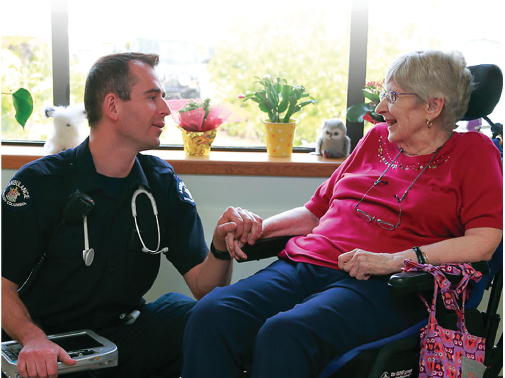Creston paramedicine pilot program could spill over into other rural areas
A paramedicine primary care pilot program set for Creston will likely have a spin off for Nelson and its surrounding areas, says an IHA health official.
Cheryl Whittleton, health service administrator for the Interior Health Authority, said the new provincial program — that will see paramedics begin to deliver primary care services — is expected to expand to other areas of the West Kootenay like Nelson.
The Community Paramedicine Initiative — which is set to begin this fall in Creston — is aimed at keeping paramedics in rural and remote areas while enabling them to “address gaps in (health care) service” said Terry Lake, Minister of Health, in a press release.
Through the program, paramedics will not replace other health care providers but, instead, support and assist them. The program will mean enhanced health care service for residents in Creston and area, said Whittleton, and eventually the rest of the West Kootenay region.
The paramedicine model will be rolled out in other communities over the next few years once phase one of the program is complete.
“We are planning to expand into phase two later in the fall, however, we have no confirmed date,” said Whittleton.
All communities that are classified as rural and remote have been identified, she explained. The BC Emergency Health Services (BCEHS) and Interior Health selected Creston — along with Princeton — as one of the prototype communities for BC’s first Community Paramedicine Initiative.
“When identifying pilot communities, we look at disease prevalence, average age in these communities, and proximity to emergency departments,” said Whittleton. “One of the criteria to ensure success of the pilots is a good working relationship between the health authority and BC Ambulance service (BCAS).”
In addition, the region could see a few more full time paramedics added to the local roster. There are 80 net new full-time-equivalent positions slated for the entire province — hired in rural and remote communities between April 1, 2015, and March 31, 2019 — but Whittleton was not sure how many new paramedic positions would be created in the West Kootenay.
“(That is) still to be determined,” she said. “These positions will be divided between the three health authorities: Northern Health, Interior Health and Island Health.”
The paramedics will be working closing with the health authority to implement the care plan that is developed for patients and clients when they are referred to any of Interior Health’s programs.
The paramedics are qualified to deliver those services and they will receive new training as well, said Whittleton.
Using a phased approach over the next four years in health districts across the province, it is expected the “rolling start” will enable community paramedics to develop the contacts needed to ensure they will be well-integrated members of the established health care teams.
During that start, paramedic unit chiefs will be working with local health care providers to define the scope of services required and participate in the development of a local service plan.
Community paramedics will be participating in programs such as community outreach and awareness, health promotion, wellness clinics and wellness checks.
The province-wide rollout is projected to begin in the fall of 2015. It will build on “lessons learned” during the initial months, and then expand to more communities in the province.
According to the BCEHS, it is anticipated that regulatory changes will be made to support a broader scope of practice, enabling community paramedics to provide services such as point-of-care testing and more advanced monitoring of chronic and complex health conditions.
Once it is implemented, the program is expected to keep paramedics in rural areas, providing permanent positions.
“They will be paid an hourly wage, versus being paid to be on-call, waiting for the next dispatch,” said Whittleton.
The program objectives are to:
- Ensure a competent, sustainable paramedic presence to respond to medical emergencies. This will be done by providing new full or regular part career opportunities in rural and remote stations, while ensuring better paramedic coverage for the community.
- Work in collaboration with local health care providers to bridge any gaps identified in the local health care system.
- Build on existing skill sets of primary or advanced care paramedics to help improve health service delivery.
Based on the experiences and lessons learned in phase one, community paramedicine program components will be developed, and the initiative expanded into other communities in British Columbia later this year and through to March 2019.


























